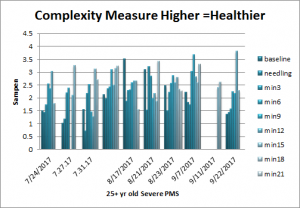HRV and PMS Clinical Case Study: Sa.Sc. Edition cont’d
Kristen Sparrow • September 25, 2017


This data is from a young woman with quite severe, disabling PMS. We are about to enter her third cycle under treatment and she is able to tell a difference. She is not as depressed or foggy. Breast tenderness is much less. So we will see how this cycle goes. Of note is that, typically, stress levels go up in the premenstrual period, and women suffering from PMS have higher stress levels. Her last treatment is a few days premenstrual. Stress levels have kept steady and had a nice decrease during treatment. We will see. Prior discussion of her case here .
.
This is her parasympathetic (rest and digest) activity, during treatment and over time. 
This is her complexity data, perhaps an equally good measure since her baseline variability is good due to her age. Complexity data can sometimes give better nuance in these cases.


